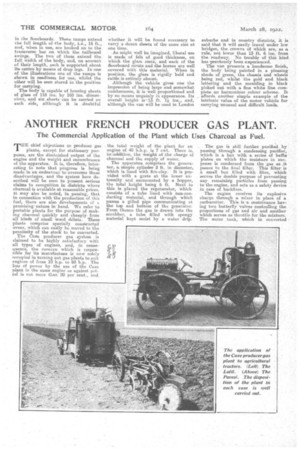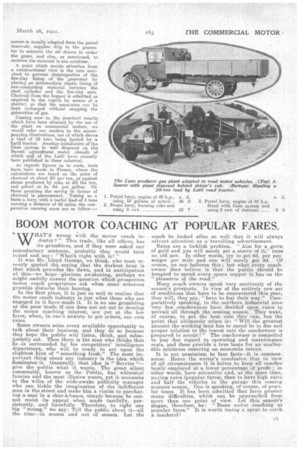ANOTHER FRENCH PRODUCER GAS PLANT.
Page 12

Page 13

If you've noticed an error in this article please click here to report it so we can fix it.
The Commercial Application of the Plant which Uses Charcoal as Fuel.
THE chief objections na producer gas plants, except for stationary purposes, are the diminished output of the engine and the weight and encumbrance of the apparatus. It is, therefore, interesting to note that progress is being made in an endeavour to overcome these disadvantages, and the system here described will be seen to present serious claims to recognition in districts where charcoal is available at reasonable prices. it may also be noted, in passing, that in connection with the production of this fuel, there are also developments of a promising •nature in hand. We refer to portable plants for the purpose of making charcoal quickly and cheaply from all kinds of small wood debris. These plants comprise specially constructed ovens, which can easily be moved to the proximity of the stock to be converted.
The Caze producer gas system is claimed to be highly satisfactory with all types of engines, and, in consequence, the concern which is responsible for its manufacture is now solely occupied in turning out gas plants to suit engines of from 10 h.p. to 60 h.p. The loss of power by the use of the Case plant in the same engine as against petrol is not more than 20 per cent., and the total weight of the plant fur an engine of 40 b.h.p. is 7 cwt. There is, imaddition, the weight of the charge of charcoal and the supply of water. The apparatus comprises the generator a simple cylinder 2 ft. in diameter, which is lined with fire-clay. It is provided with a grate at the lower extremity and surmounted by a hopper, the total height being 6 ft. Next to this is placed the regenerator, which consists of a tube lined with non-conducting material, and through which passes a gilled pipe communicating at the top and bottom of th,generator. From thence the gas is drawn into the scrubber, a tube filled with spongy material kept moist by a water drip. The gas is still further purified by passing through a condensing purifier, . which is a box with a series of baffle plates on which the moisture in suspense is condensed from the gas as it passes to the final filter. This filter is a small box filled with fibre, which serves the double purpose of preventing any remaining particles from passing to the engine, and acts as a safety device in case of backfires..
The engine receives its explosive charge through a mixer in place of a carburetter. This is a contrivance having two butterfly -valves -controlling the proportions of ggs and air and another winch serves as throttle for the mixture. The water tank, wfhich in converted
lorries is usually adapted from the petrol reservoir,. supplies drip to the generator to saturate the air drawn in under t.he grate and also, as mentioned, to moisten the material in the scrubber.
A point which merits attention from a constructional view is the ca-re exercised to prevent disintegration of the fire-clay lining of 'the generator by placing an intermediate elastic lining of non-conducting material between the steel cylinder and the fire-clay core. Charcoal from the hopper is admitted as required to the cupola by means of a shutter, so that the apparatus can be kept recharged without stopping the generation of gas.
Coming now to the practical results which have been attained by the use of the plant on commercial motors, we would refer our readers to the accompanying illustrations, one of which shows aload of 28 tons being hauled by a Lad' tractor. Another installation of the Case system is well disposed on the Po.vesi agricteltural motor (details of which and of the Latil have recently been published in these columns).
As regards figures' as to costs, tests have been made in France, where the , calculations are based on the price of charcoal at about 24 per ton, as against steam produced by coke at 23 the ton, and petrol at 3s. 8d. per gallon. On these premises the saving in favour of charcoal is phenomenal. Taking as a basis a lorry with a useful load of 4 tons running a distance of 62 miles, the comparative running costs are as follow:—
































